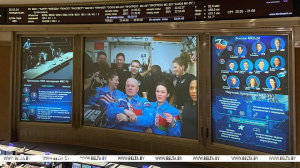Ru
|
Eng
Belarusian cosmonaut starts research program at ISS
26.03.2024

MOSCOW, 26 March (BelTA) – Belarus’ first cosmonaut Marina Vasilevskaya has started the research part of the mission to the International Space Station (ISS), the press service of the Russian space agency Roscosmos told BelTA.
According to the source, the ISS has started staging experiments according to a Belarusian program.
In particular, Roscosmos mentioned the Proxybiotic experiment (research into properties of microorganisms and their consortiums for the sake of creating a complex product to maintain human microbiota in space flight conditions) and the Magnetic Fabrication experiment (research into the possibility of controlled formation and fabrication of three-dimensional structures in microgravity out of organic and inorganic materials using magnetic fields).
The research program of the Belarusian cosmonaut has been developed by the National Academy of Sciences of Belarus in association with Roscosmos and the Russian Academy of Sciences. It includes seven experiments: five for the sake of scientific research and two for education purposes. The scientific studies will focus on biology, physiology, autonomous operation of space stations, the remote sensing of Earth using photo and video spectrum equipment of Belarusian make already on board the International Space Station. The lactoferrin and probiotics made by scientific organizations of the National Academy of Sciences of Belarus will be examined as well in order to evaluate the possibility of using them later to create food for cosmonauts.
Marina Vasilevskaya went to the ISS on board Soyuz MS-25 on 23 March as part of an international crew, which also includes the mission commander, Roscosmos cosmonaut Oleg Novitsky and the NASA astronaut Tracy Dyson. On 25 March they docked at the ISS and were welcomed by participants of the long-duration mission to the ISS: the Roscosmos cosmonauts Oleg Kononenko, Nikolai Chub, and Alexander Grebenkin and the NASA astronauts Loral O'Hara, Matthew Dominick, Michael Barratt, and Jeanette Epps.
According to Roscosmos, after arriving at the ISS the new crew was made familiar with the Russian segment of the ISS. The Soyuz MS-25 crew transfer vehicle was mothballed. Sokol-KV2 emergency spacesuits and gloves of the cosmonauts were dried and put into storage. Express goods, cargoes, and equipment for Proxybiotic, Magnetic Fabrication, Lactoferrin, and Cytomechanarium experiments were removed from the vehicle and distributed across the ISS. Apart from that, maintenance of life support systems was completed.
Marina Vasilevskaya and Oleg Novitsky are expected to get back to Earth on 6 April on board the Soyuz MS-24 spacecraft, which docked at the ISS on 15 September 2023. They will be accompanied by NASA’s Loral O’Hara who arrived at the ISS on board Soyuz MS-24.
SCIENCE. TECHNOLOGY. INNOVATIONS
13.08.2024
28.06.2024
28.06.2024
25.06.2024
05.06.2024
15.05.2024
15.05.2024
26.04.2024
26.04.2024
26.04.2024













